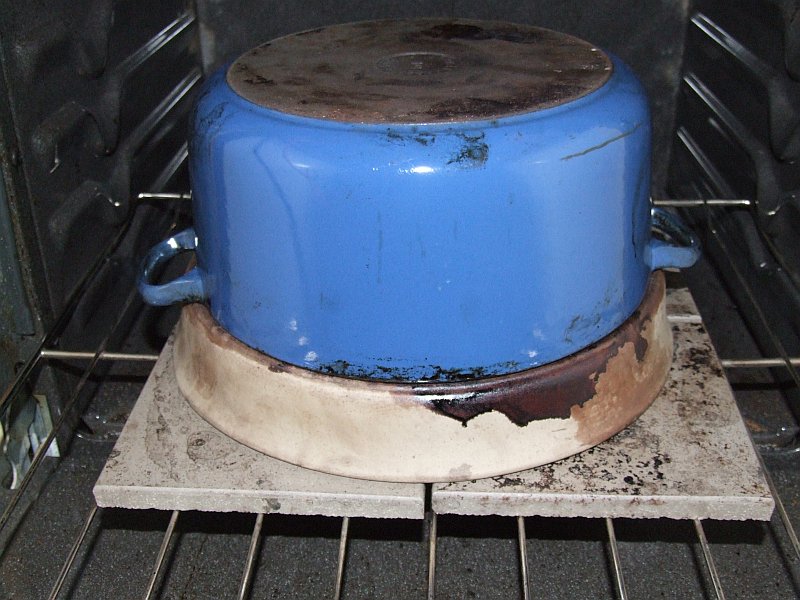
Jury-rigged Cloche
Here is a picture of my jury-rigged cloche. Not pretty but it works quite well.

It is a La Creuset round dutch oven (enameled cast-iron, I'm not sure the size) over a Sassafras "Deep Dish Pizza and Pie Baker" (ceramic), upside-down. Someone gave me this as a gift years ago and I've hardly used it until now as I'm not a deep dish pizza fan and can't imagine baking a pie in that thing.
Note that the handles of the dutch oven are not flush with the top, but the stick below the level of the rim slightly (above when right side up) so this won't work unless the deck is raised and just the right size like this pizza pan. It's sheer luck that these worked together so perfectly.
I started out using quarry tiles, with an enormous terra cotta flowerpot as the top (hole plugged with wadded up aluminum foil), but I worried that the spaces between the tiles would let steam out and defeat the purpose of the cloche. Also the flower pot is unweildy and has no handles. I've left the quarry tiles in place under the pan, but I'm not sure if they contribute anything.
The only downside is it only fits one boule at a time and you have to have decent aim delivering the loaf from the peel. I've had a couple of loaves wind up squashed on one side (which didn't impair their taste or texture, but they looked a bit wonky).
The pizza baker has developed some cracks, but I've patched them with high temperature silicone (hoping nothing toxic is coming out...I've only patched from the other side, not the baking surface). While the silicone was drying, I switched to a metal pizza pan (also upside down...and larger) with the flower pot. The couple of loaves I baked on that wound up burned slighly on one side which has never happened with the stone which always produces evenly baked loaves.
I just recieved a baker's stone from NY Bakers and intend to make myself a couple of terra cotta cloches (I'm also a potter) to replace this setup eventually, probably in different shapes and sizes. I wonder how closely the cloche needs to fit around the bread to work? Would too much space make it less effective?


Comments
A stainless steel bowl might fit over your bottom pie baker and be a lot easier to handle weight wise. A little space around your bread I don't think would make that much difference! I think it will be a lot easier when you get your new stone and you don't have to balance the heavy pot on top of your clay baker.
Sylvia
I use the up-ended flower pot and it works quite well. Hubby fastened two large washers over the hole, with a large eyebolt/nuts for a handle.
The pot seems to be just the right size...so that when I remove it there is about 1~2 inches all around the expanded loaf. Any bigger and I don't know if I'd achieve the same result.
I was dying to try that but somewhere in here it was said that clay might contain lead and perhaps dangerous. :(
Hi Anna,
Clay itself does not contain lead. The concern with lead in ceramics is that lead used to be common in a lot of ceramic glazes (the colored, often shiny, surface treatment). It's pretty rare nowadays for potters (or industrial manufacturers) to use lead (or other heavy metals) in glazes with the greater awareness and concern for food safety.
So as long as you use an unglazed flower pot--like the standard brick-red colored terra cotta kind, there is nothing to worry about. You're probably even safe with a glazed flower pot, but I think unglazed terra cotta is what you'd want for this anyway.
Eric
We used to have a restaurant in Virginia Beach, Spinnakers, and they served their breads in small flower pots and I always wanted to try that, now I will !
Thank you.
I've since found that the quarry tiles in this arrangement make a big difference. At one point I removed them (I'd used them to stack to just the right height to get a pepper next to the element for roasting, and they were gooed with carmalized pepper juice and in need of a good soak when I needed to bake bread. So I took them out and didn't bother to put them back, thinking they didn't matter.)
My bread started coming out with an overdone, even burnt, bottom crust. I didn't dawn on me immediately why. At first I figuted I must have forgotten to clean away the charred semolina from the last batch. But after a few loaves like this the message penetrated my skull: no quarry tiles meant burned crust. Apparently the pizza pan / stone I use isn't thick enough to diffuse the heat from the element not far beneath. The tiles do a nice job of diffusing it and after putting them back, my bottom crust is perfect again.